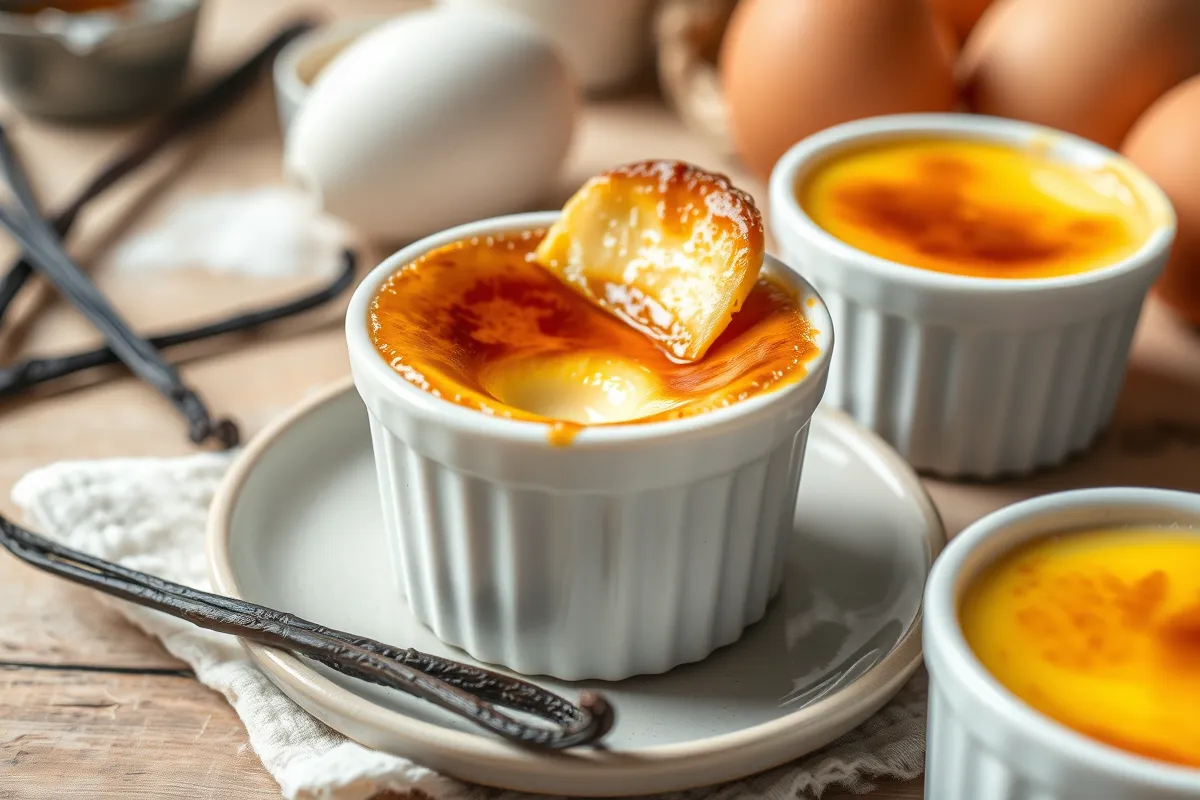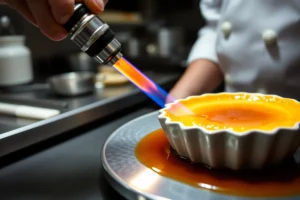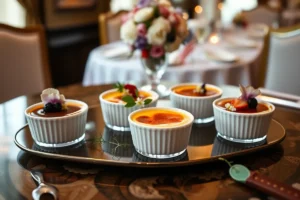What is the secret of crème brûlée is a question that has intrigued dessert lovers for centuries. This iconic French dessert, with its velvety custard and crisp caramel topping, seems deceptively simple yet requires finesse to perfect. From selecting the right ingredients to nailing the caramelization process, there’s a lot to uncover. In this article, we’ll delve into the history, techniques, and secrets behind crafting the ultimate crème brûlée. Whether you’re a novice or an expert, you’re bound to pick up tips that elevate your dessert game.
Part 1: What Is the Secret of Crème Brûlée?
Crème brûlée, meaning “burnt cream” in French, is not just a dessert—it’s a culinary masterpiece. Its simplicity in ingredients contrasts sharply with the precision it demands during preparation. To truly understand its allure, we must first decode its charm.
The Origins of Crème Brûlée
The history of crème brûlée is as rich as its custard. This dessert traces its roots back to 17th-century Europe, where it was a symbol of luxury and sophistication. While France claims ownership, similar versions existed in England (Trinity Cream) and Spain (Crema Catalana). Its defining feature—the caramelized sugar crust—was both a flavor enhancer and a preservation method in times when refrigeration was unavailable.
Over time, crème brûlée evolved into the beloved dessert we know today, celebrated not just in French cuisine but worldwide. Its enduring popularity lies in the delicate balance it strikes between a creamy base and the crunch of caramelized sugar.
The Allure of Crème Brûlée in Modern Cuisine
Why does crème brûlée continue to captivate food enthusiasts? Its versatility is part of the answer. While the classic vanilla flavor remains iconic, chefs constantly push boundaries, infusing it with seasonal ingredients like lavender or citrus. Moreover, it’s an experiential dessert—the satisfying crack of the caramelized top sets the tone for its indulgent creaminess beneath.
Paired with simple yet quality ingredients, crème brûlée transforms into a dessert that feels both extravagant and comforting. Its appeal lies in its duality—easy enough for home cooks yet sophisticated enough for fine dining.
Part 2: Understanding the Components
Creating the perfect crème brûlée begins with understanding its essential ingredients. Despite its short list of components, each plays a crucial role in achieving the dessert’s signature texture and flavor. Let’s explore the key ingredients that make this timeless dessert so extraordinary.
Key Ingredients for a Perfect Crème Brûlée
At its core, crème brûlée is a blend of cream, egg yolks, sugar, and vanilla. However, the secret lies not just in using these ingredients but in choosing the best quality available. Each component contributes uniquely to the final product, influencing its texture, flavor, and overall appeal.
Selecting Quality Dairy Products
The creamy foundation of crème brûlée relies heavily on high-quality dairy. Heavy cream is preferred for its rich fat content, which gives the custard its signature smoothness. While milk is sometimes added to adjust the richness, using pure cream ensures a luxurious consistency.
When selecting cream, choose fresh, pasteurized varieties free from additives. If possible, opt for organic or local dairy, as the purity of flavor directly affects the custard’s taste. Using subpar cream can lead to a thinner texture, robbing the dessert of its indulgent essence.
For adventurous cooks, incorporating subtle flavors like coconut cream or almond milk can create interesting variations, though they alter the classic texture.
The Role of Egg Yolks in Custard
Egg yolks are the backbone of any custard-based dessert, and crème brûlée is no exception. They act as both a thickener and an emulsifier, binding the cream and sugar into a velvety mixture.
The number of yolks used directly impacts the dessert’s texture. Too few, and the custard won’t set properly; too many, and the result might feel overly dense. A balance is essential to achieve the light yet rich consistency that defines a perfect crème brûlée.
When separating eggs, take care not to let any whites mix in, as they can lead to a rubbery texture. And here’s a pro tip: always whisk the yolks gently to avoid incorporating air bubbles, which can cause uneven baking.
Importance of Sugar and Vanilla
Sugar serves two crucial purposes in crème brûlée: sweetening the custard and creating the caramelized crust. Fine granulated sugar is the best choice for both tasks due to its even texture and quick melting properties. For the caramel layer, using superfine or caster sugar ensures a uniform crust that’s easy to torch.
Vanilla, meanwhile, is the heart of the custard’s flavor. Authenticity is key here—opt for real vanilla beans or high-quality vanilla extract instead of synthetic options. Vanilla beans, with their flecks of seeds, not only infuse the custard with a deeper flavor but also add a visual element of sophistication.
For variation, try infusing other flavors like orange zest or cardamom into the cream before combining it with the yolks and sugar. These subtle additions can elevate the dessert without overshadowing its classic appeal.
Part 3: The Art of Preparation
Mastering the art of preparation is where crème brûlée transforms from a simple recipe into a culinary achievement. Each step, from crafting the custard to baking it perfectly, requires precision and patience. Here’s how to bring it all together.
Crafting the Ideal Custard Base
Creating a creamy and flavorful custard base is the foundation of crème brûlée. This process demands a harmonious blend of your key ingredients—cream, egg yolks, sugar, and vanilla—to achieve the perfect texture and flavor.
Techniques for Mixing Ingredients
The secret to a smooth custard lies in how you combine your ingredients. Start by whisking the egg yolks and sugar until pale and slightly thickened. This step ensures that the sugar dissolves, preventing a grainy texture.
When adding the heated cream, go slow! Pour it gradually into the egg mixture while continuously whisking. This technique, known as tempering, prevents the eggs from curdling by slowly raising their temperature. Skip this step, and you risk scrambled eggs instead of silky custard.
Achieving the Right Consistency
The custard mixture should be slightly thick but still pourable before baking. To check consistency, use the back of a spoon—if the mixture coats it evenly without dripping, it’s ready.
Straining the custard through a fine sieve is an often-overlooked step but essential for removing any clumps or air bubbles. This ensures a velvety smooth texture that defines a perfect crème brûlée.
Baking to Perfection
Baking is where the magic happens, turning a liquid custard into a creamy, set dessert. The key is even and gentle heat, which is why the water bath method is indispensable.
The Significance of the Water Bath
A water bath, or bain-marie, involves placing your ramekins in a baking dish filled with hot water. This technique ensures the custard cooks evenly without curdling or developing a rubbery texture.
When preparing the water bath, use hot but not boiling water, filling the dish until it reaches halfway up the sides of the ramekins. Covering the baking dish lightly with foil can help maintain consistent heat, especially in ovens prone to temperature fluctuations.
Determining Doneness
Knowing when your crème brûlée is done can be tricky. The custard should jiggle slightly in the center when gently shaken but appear set around the edges. Overbaking results in a grainy texture, so keep a close eye during the last few minutes.
A good rule of thumb is to bake at 300°F (150°C) for about 30-40 minutes, though this may vary based on ramekin size. Allow the custard to cool at room temperature before refrigerating to let it fully set.
Part 4: Mastering the Caramelized Topping
The crowning glory of crème brûlée is undoubtedly its caramelized sugar crust. Achieving the perfect layer involves attention to detail, from sugar choice to the caramelization process itself.
Creating the Signature Caramel Crust
The caramelized topping is what elevates crème brûlée into a sensory experience. The contrast between the creamy custard and the crackling caramel layer creates a delightful interplay of textures and flavors.
Sugar Selection and Application
The type of sugar you use greatly affects the caramel layer. Superfine or caster sugar is ideal because it melts evenly and quickly under heat. Avoid coarse or granulated sugar, as it can lead to uneven caramelization.
To apply, sprinkle a thin, even layer of sugar over the custard’s surface. Too much sugar can result in a thick crust that overpowers the custard, while too little won’t provide the satisfying crunch. A light, consistent coating is key.
Tools and Techniques for Caramelization
A culinary torch is the go-to tool for caramelizing the sugar. Its direct, high heat ensures precise control, allowing you to create a golden-brown crust without heating the custard underneath.
If a torch isn’t available, you can use your oven’s broiler. However, this method requires caution as it’s harder to control the caramelization. Keep a close eye and rotate the ramekins for even browning.
Allow the caramelized topping to cool for a minute or two before serving. This ensures it hardens into that signature brittle layer, ready to crack under your spoon.
Part 5: Serving and Enjoying Crème Brûlée
Once you’ve mastered the delicate balance of custard and caramel, it’s time to enjoy your crème brûlée masterpiece. The way you present and pair this dessert can take it to the next level, ensuring a memorable experience for you and your guests.
Presentation and Pairings
The charm of crème brûlée lies not just in its flavor but also in its aesthetic appeal. A thoughtful presentation can make your dessert even more inviting.
Ideal Serving Temperatures
Crème brûlée is best served slightly chilled. The custard should feel cool and creamy, contrasting with the warm crunch of the caramelized topping. However, avoid serving it straight from the fridge, as an icy cold custard dulls its flavors.
To achieve the perfect serving temperature, remove the dessert from the refrigerator about 20 minutes before serving. This allows the custard to soften slightly while maintaining its firm texture. The caramel crust should be freshly torched to ensure it’s crisp.
Complementary Desserts and Beverages
Pairing crème brûlée with the right accompaniments can elevate its enjoyment. Fresh fruits like raspberries, strawberries, or blackberries add a burst of brightness that complements the dessert’s rich flavor. A dollop of whipped cream or a sprig of mint can also enhance the presentation.
For beverages, consider light and aromatic options like herbal tea or sparkling water with a hint of citrus. These pairings cleanse the palate, allowing the complex flavors of the custard and caramel to shine. Avoid overly sweet pairings, which can overwhelm the dessert’s subtle elegance.
Part 6: Variations and Innovations
While the classic vanilla crème brûlée is a timeless favorite, experimenting with flavors and ingredients can add a creative twist to this beloved dessert. From infusions to seasonal touches, the possibilities are endless.
Exploring Flavor Variations
One of the joys of crème brûlée is its adaptability. You can easily transform the base recipe by introducing new flavors that align with your taste or the season.
Infusing Different Aromas
Infusing the cream with different aromas before combining it with the yolks and sugar is an excellent way to add unique flavors. Popular infusions include lavender, matcha, coffee, or even chai spices. Simply heat the cream with your chosen ingredient, then strain it before proceeding with the recipe.
Vanilla can still play a supporting role in these variations, adding depth to the new flavor profile. By incorporating subtle yet aromatic infusions, you can create a crème brûlée that feels familiar yet refreshingly different.
Incorporating Seasonal Ingredients
Another way to innovate is by using seasonal ingredients. During summer, citrus zest (like orange or lemon) can add a zippy brightness to the custard. In autumn, spices such as cinnamon or nutmeg bring a cozy warmth.
Fruits can also be incorporated, either as a flavor infusion or as a topping. For instance, mango puree blended into the custard creates a tropical twist, while caramelized apples or pears on top add texture and sweetness. These variations keep crème brûlée exciting for all occasions.
Part 7: Troubleshooting Common Issues
Even seasoned cooks encounter challenges when making crème brûlée. Its delicate nature means small missteps can lead to less-than-ideal results. Here’s how to address common problems and ensure your dessert turns out flawlessly every time.
Addressing Common Mistakes
Mistakes in texture, flavor, or appearance are often the result of overlooked details. Whether your custard is too firm, the caramel uneven, or the overall taste is off, understanding these issues can help you refine your technique.
Preventing Custard Curdling
One of the most common pitfalls in making crème brûlée is curdled custard. This happens when the eggs cook too quickly, leading to a grainy texture. To prevent this:
- Use a low and consistent oven temperature. High heat causes the eggs to scramble.
- Always temper the eggs by adding warm cream slowly while whisking continuously. This gradual process prevents the eggs from cooking prematurely.
- Opt for a water bath, as it ensures gentle, even heat around the ramekins.
If your custard does curdle, it’s challenging to salvage. Prevention is key, so take your time during each step.
Achieving a Uniform Caramel Layer
A perfect caramel crust is the hallmark of crème brûlée, but uneven or burnt sugar can spoil the experience. Common issues include clumping sugar, overly thick layers, or inconsistent browning. To avoid these:
- Use superfine or caster sugar for even caramelization.
- Ensure the sugar is spread evenly across the custard’s surface. Tapping the ramekin gently can help distribute it.
- When using a torch, move it in circular motions to avoid burning one spot. Keep the flame at a consistent distance for uniform browning.
If you notice any uneven areas, sprinkle a bit more sugar and torch lightly to smooth it out. Practice makes perfect when it comes to mastering this step!
Part 8: Frequently Asked Questions
Crème brûlée often sparks curiosity among dessert enthusiasts. Below are some of the most commonly asked questions, complete with expert answers to guide you.
What is the origin of crème brûlée?
Crème brûlée originated in 17th-century France, though similar desserts were made in England (Trinity Cream) and Spain (Crema Catalana). Its caramelized sugar crust became its signature feature, setting it apart from other custards.
Can I make crème brûlée without a torch?
Yes, you can use your oven’s broiler as an alternative. Place the ramekins close to the heat source and watch carefully to avoid burning the sugar. Rotating the ramekins ensures even caramelization.
How do I store leftover crème brûlée?
To store leftover crème brûlée, cover it tightly with plastic wrap and refrigerate for up to two days. For best results, caramelize the sugar topping just before serving, as it can soften over time.
Why is my custard not setting properly?
If your custard is too loose, it may not have been baked long enough, or the oven temperature could have been too low. Always check for a slight jiggle in the center and ensure the water bath is properly heated.
What sugars are best for caramelizing the top?
Superfine sugar is ideal for a smooth and even caramel layer. Granulated sugar works as well but may require more time to melt evenly. Avoid powdered or brown sugar, as they can create an uneven texture.
How can I infuse different flavors into the custard?
You can infuse flavors like lavender, citrus zest, or spices by heating them with the cream before straining. This step adds depth without altering the custard’s creamy texture.
This concludes the guide to mastering crème brûlée, from troubleshooting common issues to answering frequently asked questions. Armed with these tips, you’re ready to create a dessert that’s as flawless as it is delicious!



